I recently had the opportunity to make a presentation on “How to Make Pasta Without a Machine” at the Orange County Fair. For those who couldn’t make it, I wanted to share that information here. I have answers to your questions about which flour to use, which are the easiest shapes to make, and more.
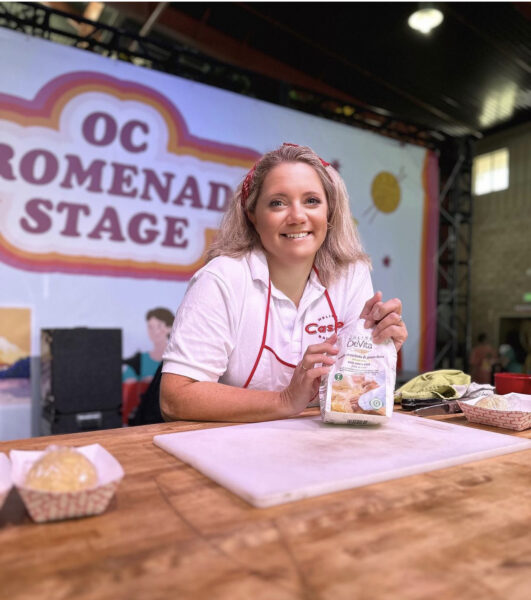
At the OC Fair Promenade Stage for the pasta demonstration (Photo credit: Altalunas International)
(This post may contain affiliate links. If you buy certain products through links from this page, I may earn a small commission, at no cost to you. Thank you for your support of Jolly Tomato.)
Why Make Your Own Pasta?
The first question most people ask is, why make your own pasta? Pasta is easily accessible at any store. Open a box or bag, boil it, and you’re done. To that question I have three answers: One, homemade pasta just tastes better. Two, homemade pasta is easier than you think. And three, making your own pasta is a true act of love. If you tell someone, “I made you some homemade pasta,” it’s a wonderful gesture – and the prelude to a delicious meal.
I would not have had all of this knowledge about Italian flours and pasta-making had it not been for my trip to Italy with the Pure Flour from Europe campaign and ITALMOPA (the Italian flour manufacturers’ association). Below are three hand-made varieties of cavatelli that we enjoyed during our pasta-making education in Rome, Puglia, and Naples.
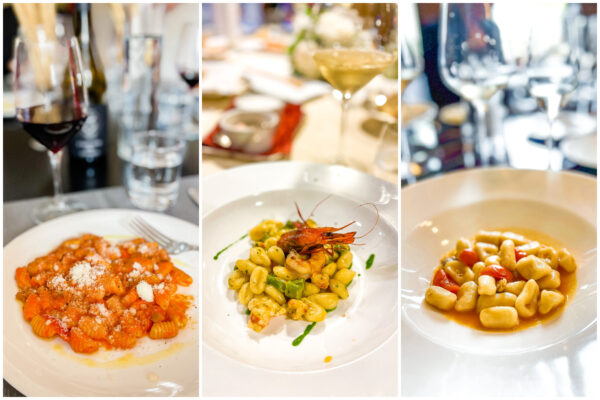
These three dishes are: 1) Cavatelli that we made in our class at Fabiolous Cooking Day. 2) Cavatelli served at La Cantinella restaurant in Naples. 3) Cavatelli made by Chef Lino Acunzo at a pasta-making demonstration and served at Hotel Glam in Rome. Of course, they were so delicious they inspired me to want to lead a tutorial back in the U.S. about how to make pasta by hand – and which flours to use.
Why Make Pasta Without A Machine?
One of the primary reasons I wanted to do this presentation on making pasta without a machine was to demonstrate just how simple it truly is. Every culture has some form of noodle or dumpling. And people have been making pasta (or noodles, or dumplings) without fancy machinery for centuries. Many forms of pasta are so easy to make, you could just put your kids in charge. The recipe is very straightforward and simple.
What Flour Should I Use to Make Pasta?
This is such a great question to start with because it determines the very foundation of your pasta. Let’s start with the wheat. There are two main types of wheat used to make flour for pasta: Soft wheat and durum wheat. Soft wheat is, like the name says, soft. The American all-purpose flour is made from soft wheat. American all-purpose flour is roughly equivalent to Italian 0 flour. (The “0” indicates the fineness of the grind.) The Italians also go one step finer with 00 flour. 00 flour is often used as the base for Italian pizzas and pastas. You can find it in most any well-stocked grocery store.
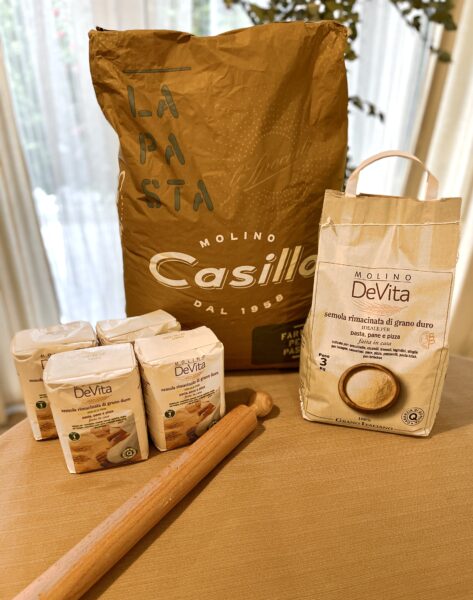
Italian flour from the two flour mills we visited in Puglia: Molino Casillo and Molino DeVita, as seen at the site of one of our pasta-making classes at Relais in Contrada.
Next there’s durum wheat, which is heavier, harder, sturdier, and higher in gluten. Durum wheat is ground into semolina flour. Because it is sturdier, semolina flour is the flour most frequently used for dried pastas you can buy in a box. You can find semolina flour in most well-stocked grocery stores. But what’s a little harder to find is “semola rimacinata,” which is a finer grind of semolina flour, mostly found in Italy. Semola rimacinata is the base for a lot of sturdier hand-made pastas, such as cavatelli, which we will get to next. We have not had much luck finding semola rimacinata in American stores yet (although stay tuned for that!) but you can find it in some specialty Italian food stores or order it online.

Making Semolina Pasta Dough
The recipe for semolina pasta dough is very simple: 100 grams of semola rimacinata to 50 grams of water. Place the flour on the board, make a small well in the center, then slowly mix in the water. (A bench scraper – a lovely flat-edged scraper that costs about $8 – helps with this process.)
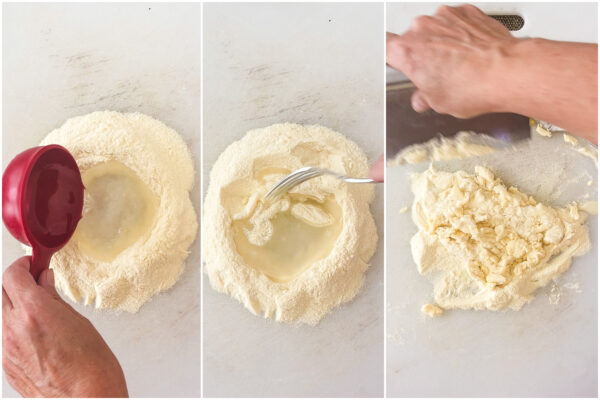
Once you have a ball of dough, knead it for about five minutes. (Fold over, press down, turn a quarter-turn, repeat.) This works the gluten in the flour. Then cover the dough ball (so it doesn’t dry out) and let it rest for 30 minutes before you begin to shape it.
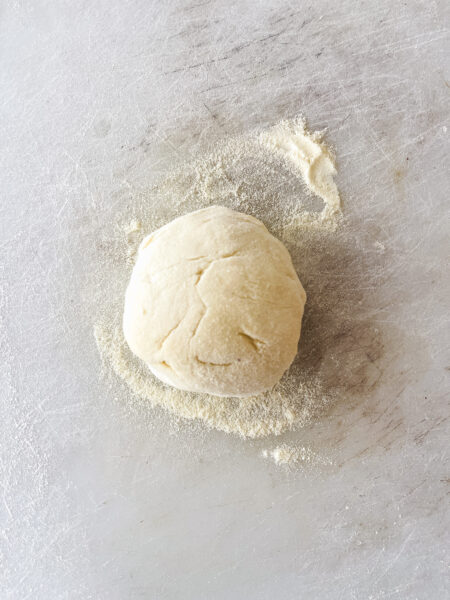
Making Cavatelli with Semolina Pasta Dough
The first pasta you can make by hand is a very simple cavatelli. “Cavatelli” means “little hollows” or “little dimples” – but I like to remember it as “little caves.” Cavatelli looks like a little bean, but folded over with an indentation in the middle. It is great for collecting whatever sauce you serve it with.
Once you have a ball of semolina dough, knead it for about five minutes. (Fold over, press down, turn a quarter-turn, repeat.) This works the gluten in the flour. Then cover the dough ball (so it doesn’t dry out) and let it rest for 30 minutes.
When you’re ready to work with it, cut the dough ball into small slices. Take a single slice and roll it out on a board into a one- to one-and-a-half centimeter wide rope.
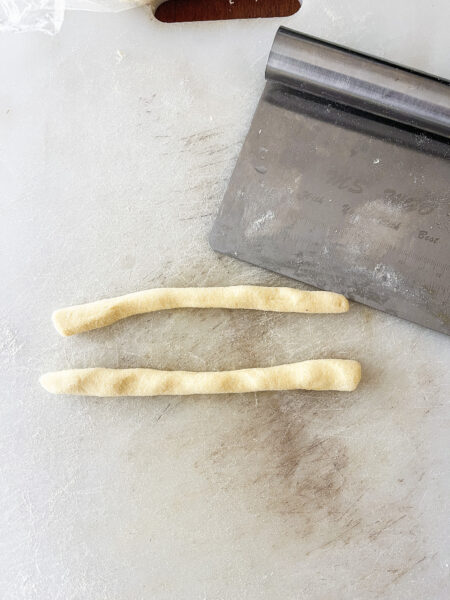
Cut the rope into pea-sized pieces. Now you’ve got three options, pictured here from left to right:
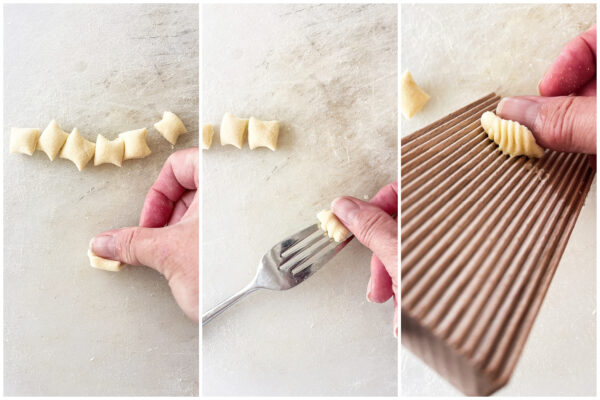
- Take the pea-sized ball of dough, place your thumb on it sideways, and roll it across the board. It should curl into itself and make a little dimpled bean shape.
- Take a pea-sized ball of dough, and once again using your thumb, roll it down the back of a fork. This should create ridges in your cavatelli – perfect for capturing sauce.
- Using a pea-sized ball of dough, use your thumb to roll it down a gnocchi board. (A gnocchi board is a very simple wooden wedge, available on Amazon for about $9.) This tool will give the cavatelli fine, tiny ridges that look very professional.
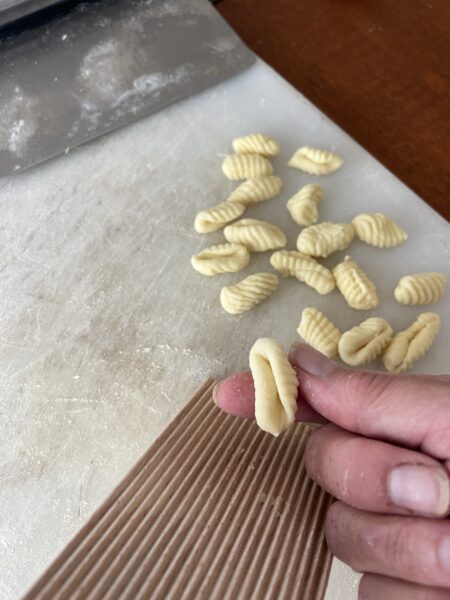
Once you have a pile of cavatelli, add it to boiling water (about 6-8 quarts of boiling water for 2-3 cups of pasta) with about 1/2 teaspoon of salt. Let them boil for 3-5 minutes, or until they rise to the top.
Making Trofie with Semolina Pasta Dough
Trofie is another fun and easy pasta shape to make with semolina dough. Trofie doesn’t have a direct translation, but it relates to the root word for “twist” or “turn,” which is what you do to make this spiral pasta shape. It comes from the Liguria region of Italy and it is the perfect pasta for pesto sauce.
You start the same way as with the cavatelli. Cut your dough ball into small slices. Take a single slice and roll it out on a board into a one- to one-and-a-half centimeter wide rope. Cut the rope into pea-sized pieces.
Then you’re going to do two steps. The first step is to roll a pea-sized piece into a skinny strip. Then, with your hand perpendicular to the board, draw your hand back toward you diagonally (as if you’re drawing a backwards slash with your hand), and press your pinky down on the dough as you drag it so the dough turns into a spiral. Then repeat.
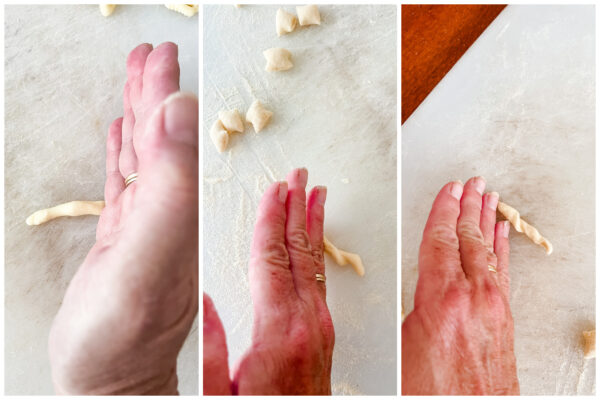
Try to make sure your pieces are relatively even in size and thickness so they will cook evenly. This pasta will cook in boiling water for about three minutes.
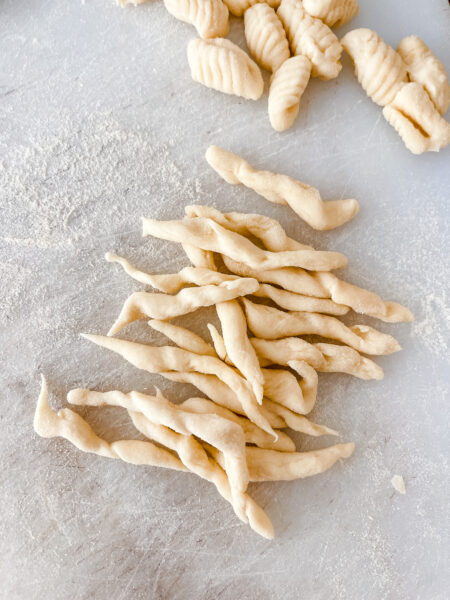
Making OO Flour Pasta Dough
This pasta dough is also simple to make, using Italian 00 flour. The recipe is 100 grams of 00 flour to 1 large egg. (I usually add one teaspoon of extra virgin olive oil as well – Olio Piro from Tuscany is my olive oil of choice!) Given that eggs vary in size, you may need to add slightly more liquid or flour. You are aiming for a texture that is similar to play dough; not too wet and not too dry.
Again, you will place the flour on a board, make a small well in the center, then slowly mix in the egg and the olive oil. (A bench scraper helps with this process.)
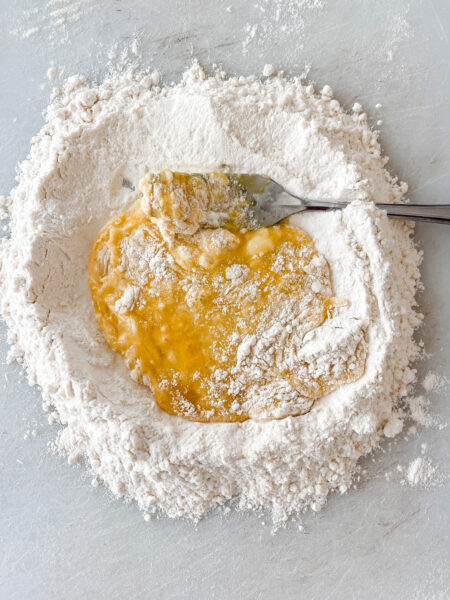
Once you have a ball of dough, knead it for about five minutes. (Fold over, press down, turn a quarter-turn, repeat.) This works the gluten in the flour. Then cover the dough ball (so it doesn’t dry out) and let it rest for 30 minutes before you begin to shape it.
Making Tagliatelle with 00 Flour Pasta Dough
Tagliatelle is a flat noodle about 1/4 inch wide. It originated in the Emilia-Romagna region of Italy, although it is now popular all over. This pasta is most popularly served with bolognese (a meat sauce) – but you can enjoy it with almost any sauce. Most of the time people make tagliatelle with a machine, but it is possible to roll it out by hand.
Taking your 00 pasta dough, roll it out on a floured board into a small circle, fold it in half, and repeat. Then start rolling with more intensity, rotating the dough so that it stretches evenly on all sides. Keep rolling until it is thin enough that you can more or less see your hand through it (about 1/16 inch thick). Trim the edges so you have a nice rectangle. Then lightly dust the top surface with flour.
Now you are going to fold the top end about 1/4 of the way down. Repeat with the bottom end. Then fold again so the top and bottom ends meet in the middle.
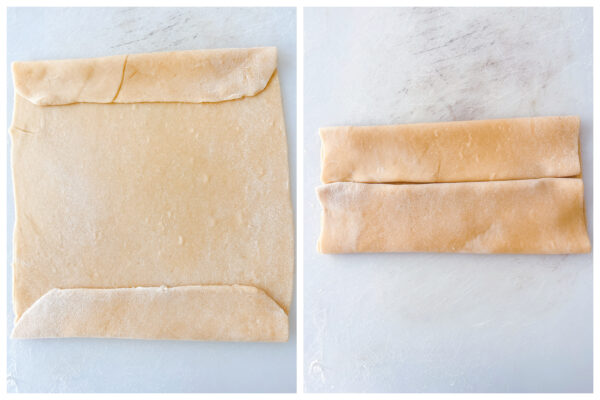
Next, slice the dough into 1/4-inch-wide slices, using a gentle rocking motion with a large sharp knife so that the thin layers don’t get mushed. Finally, slide the knife under the pasta, lift up the knife, and let the noodles fall down from the center.
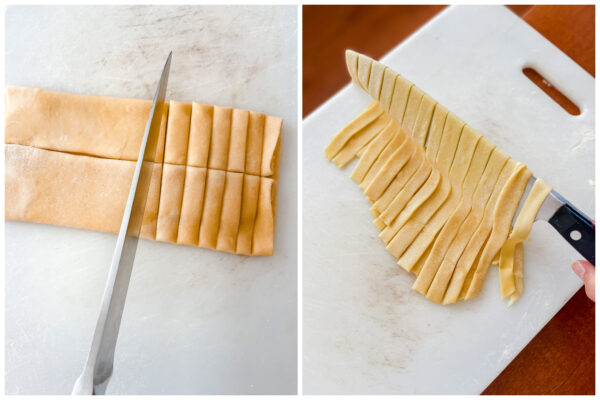
Dust them again lightly with flour, and ideally, cook them immediately (or cover them with plastic wrap until you are ready to use them). When you add them to boiling water, they should cook in about two minutes.
Pure Flour From Europe
The best recommendation I can give for great pasta is to use Italian 00 soft wheat flour, and Italian Semola Rimacinata (extra-fine semolina flour).
The European Union’s flour industry is known for its cutting-edge technology, highest safety and purity standards, and sustainable processes. Italy leads the pack, with 233 mills producing over 4 million tons of flour per year. (We had a chance to tour two of those mills – Molino Casillo and Molina DeVita – that produced the flours pictured above.). By milling soft wheat and durum wheat to make flours for breads, pizzas, and pastas – the staples of the Italian diet – Italy is both the source and consumer of some of the world’s finest flours. Your best bet for buying these flours is through mail order or at an Italian specialty store. But again, keep looking – there will be more coming to American grocery store shelves soon.
Good luck with your pasta and buon appetito!
Blogger disclosure: I did not receive compensation for this post. Many of the ideas reflected in this post were learned on my trip to Italy with the Pure Flour from Europe Campaign. All opinions expressed are my own.

 Hi! I'm Jeanne Fratello - a writer, reporter, and food enthusiast who is on a mission to write great stories about food and where your food comes from.
Hi! I'm Jeanne Fratello - a writer, reporter, and food enthusiast who is on a mission to write great stories about food and where your food comes from.
No comments yet.